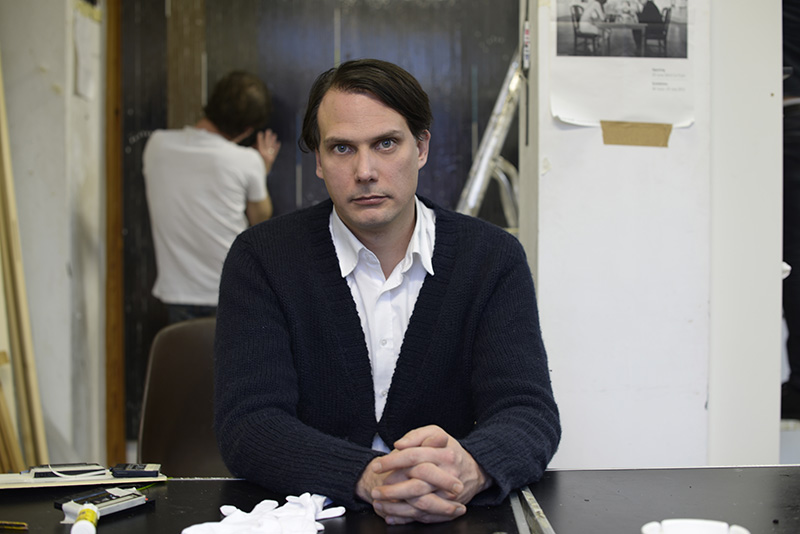INTERVIEW: Gregor Hildebrandt
Every one artwork of Gregor Hildebrandt carries within it a specific song, film or poem, as he makes extensive use of pre-recorded cassette tapes as material in his work. He belongs to the new generation of German artists, who lives and works in Berlin, he has deeply influenced in his work not from tendency and movements of our times, especially he was influenced by the Museum Collection of Saarbrücken, his birthplace. On the occasion of his solo exhibition “Alle Schläge sind erlaubt” at Almine Rech Gallery in Paris, Gregor Hildebrandt unfolds the collage of images and sounds that seize his canvases.
By Dimitris Lempesis
Photo: Almine Rech Gallery Archive
Gregor Hildebrandt, Photo: Luise Mueller-Hofstede
Mr. Hildebrandt, the basic technique in your work is collage, it has been used in contemporary art from Pablo Picasso and the Dadaists until today in many and different ways, which is the role of collage in your work?
In my work, the use of collage results in rather conceptual approach of painting: I have always wanted to paint like The Cure, for instance, makes music. Moreover, what is important to me in this conceptual approach is the “charge“ or the “added value” that constitutes the presence of these inaudible songs.
Despite the monochrome in your paintings that refers to corresponding artists, we see a distinction and an inner strength that is adjacent to the German Expressionism and Neue Wilden, what is the connection between their your work and yours?
I grew up in Germany and was inevitably influenced by the museum collections of my surroundings. As a consequence, there is a strong focus on German Art in my work. In Saarbrücken, the city I come from, the collection focuses on German Informalism: with artists or artists groups, such as Gerhard Hoehme, Norbert Kricke, Frankfurter Quadriga, Karl Otto Götz and Emil Schuhmacher. Since I am in general very interested in Art, these influences echo also in my work.
You are covering your canvases with tape ribbons, a material that for many of us is associated with the music and its history, also the way we all used them to create our own music and sound collage. What is your relationship with music and how did you decide to use the tapes and vinyl records in your work?
I always choose music that I like very much and to which I feel connected. The songs I pick also needs to have a thematic connection with the painting on which they will be or the exhibition they be will part of. For instance, in my exhibition “Bilder malen wie Cure“ at Galerie Perrotin in Seoul, I have only used songs by The Cure.
Is there a tape or a vinyl record that its emotional value is so special for you, that you would you place it in a prominent position in your archive that to use it in your work?
The album Pornography by The Cure.
Mr. Hildebrandt as we observe many titles of your works are referring to music from antiquity like “Orphische Schatten”, to nowadays artists such as: David Bowie or Sonic Youth. Is music a key source for your work?
Yes, it is at core in my work. As you mentioned the titles of my works refers to songs or to their lyrics. These titles have their own poetical resonance, but give also an indication on the songs contained in the paintings. In the case of video tape paintings or „walls“, they refer to the film recorded on the tape. For the exhibition “Orphische Schatten“ at Almine Rech Gallery in Brussels (2013) for instance, I recorded the film “Orphée“ de Jean Cocteau on the video tape walls that surrounded the main exhibition room. The paintings hung on these walls contained songs by Einstürzende Neubauten, The Smiths or the poem “Sonette an Orpheus“ by Rainer Maria Rilke that starts with the line “Sei allem Abschied voran…“ (Be ahead of all parting…).
What is the connection of your work “Joy Division- ‘Substance’” with the debut album of by Joy Division “Unknown Pleasures”?
For the work “Joy Division- ´Substance´” (2007), I recorded the audio-cassette tape with the album “Unknown pleasure“ by Joy Division. The motif on the painting is inspired by the motif of the cover, which was made by Peter Saville. In this particular case, the title refers to another album, because I wanted to refer to the signification of the word “substance“.
Info: Almine Rech Gallery, 64 Rue de Turenne, Paris, Duration: 12/1-25/2/17, Days & Hours: Tue-Sat 11:00-19:00, www.alminerech.com
First Publication: www.dreamideamachine.com
© Interview Dimitris Lempesis







